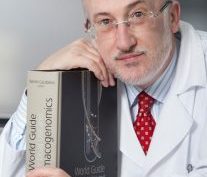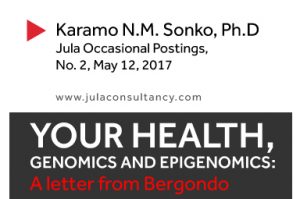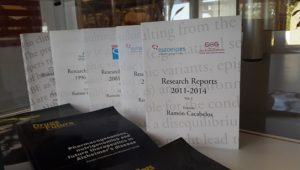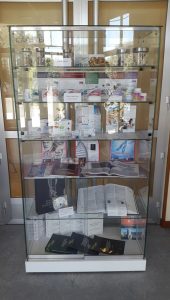Articles/Publications
YOUR HEALTH, GENOMICS AND EPIGENOMICS
Posted by admin


Dear friend,
Have you ever asked yourself why you contracted a particular disease? Or the likelihood of you contracting one? How many times have you been to a doctor who only wrote a prescription for you, which you simply bought and happily swallowed? Have you considered the side effects of drugs, even the common pain killers you may be taking often? Do you know how many people around the world die or are impaired for life because of the effects of the wrong medications?
Whether “Yes” or “No”, please read this message from the top of a mountain, surrounded by green trees and grass, overlooking the Lake Cecebre. It is a message for the healthy and the sick, from a friend.
Galicia is in Northern Spain. It is known as the “land of the 1,000 rivers”. It is beautiful here and wild deer sometimes tip the balance in their favour on the well built roads. In its mountains is a very small province, in the municipality of A Coruña (Galician, in Spanish “La Coruña”). The province has only about 7,000 people and it is called Bergondo. Here lies a square building with an open front, in a green valley and field. Inside the building sits a grey-haired, but clean-limbed, professor, medical doctor and scholar of a difference. His name is Ramón Cacabelos. I heard about him recently through an Emirati friend and airline captain, Mohamed Hashidi, who landed his A380 a number of times in this nation of “Hola!” and “Vale!”.
Why Japan?
When Ramón finished his first degree in medicine and surgery at the University of Oviedo in Spain in 1980, he decided to go for a specialization in brain diseases. He had three choices: 1) to return to California, where he first went as a teenager for an English language summer course at the University of California, Berkeley; 2) to go to the World Health Organization (WHO) in Geneva as a research fellow; or 3) to go to Japan. The Japanese Government was at the time looking for a very small group of international geniuses to sprinkle over its universities.
Ramón applied in all three countries and got a scholarship in each. Unlike most people, he decided to go for the unknown and what seemed the most challenging: Japan. “The Japanese,“ he noted, “has a culture of hard work. ”
He was one of the only two applicants selected out of 400 from Spain (the other was a plasma physicist). He did not speak a word of Japanese. Therefore, he had to spend his first semester learning Japanese culture and language. Out of a total of 124 successful candidates worldwide that year, only 68 passed the final examinations of the preparatory semester and Ramón was one of them. Consequently, he was sent to Osaka University, which had one of the best departments of neuropsychiatry in the world.
At the time, medical scientists only knew that histamine was a regulator of secretion and allergic reactions. Ramón discovered that it was also a neurotransmitter in the brain. He registered his first patent in 1986 as Osaka University’s Computerized Electronic Maze (OCEM 86). Working with his Japanese professors and colleagues, they located the pathways and neurons where histamine is located. They found out that histamine was important in neurodegeneration, such as Alzheimer’s disease, epilepsy, sleep disorders and hormonal regulation.
In addition, Ramón invented a computer system to investigate memory and learning in experimental animals.
These two reasons attracted the attention of the Japanese to Ramón even more. He was to leave after one year, but was invited to stay longer. He ended up spending ten years of his life in Japan.
The human genomics project started in the US in 1986 and Ramón became involved right away. He started to develop genomic medicine in personalized treatment of CNS (brain disorders). He was awarded a Ph.D in medical science, internal medicine and psychiatry, specializing in psychiatry at the Faculty of Medicine of Osaka University in 1987.
When Dr Cacabelos returned to Spain he started his academic career at Santiago University and then moved to Madrid University, where he got tenure. He founded EuroEspes Biomedical Research Center and Institute of Medical Science and Genomic Medicine in 1991. He calls it “a European initiative and revolutionary concept.” Revolutionary, because 98 percent of the hospitals in Spain were publicly owned. It was, and perhaps still is, the only public-private funded medical institution in the country. He wants it that way, because he does not want to have any political interference in running the Center and Institute.
Since then other institutions in Europe have followed suit and copied the EuroEspes model.
Rationale
I asked Professor Cacabelos why he took the initiative. “The necessity! I felt that we needed independent institutions in Spain dedicated to the investigation, diagnosis and treatment of brain disorders, especially dementia and age-related and neuropsychiatric disorders.”
Nationalities
People come to EuroEspes from most of the developed and wealthiest countries in the world. Twenty percent of patients come from abroad: the EU, the Gulf, South America, North America, Asia and North Africa.
What is genomics?
Before visiting EuroEspes I had only story-book or Hollywood knowledge of genomics. I heard about it as a field in which eccentric and unethical scientists and military establishments are trying to clone or biologically modify the human being. “This,” the Professor pointed out, “is the fantasy about genomics!”
“Genomics”, he pointed out, “is the library of life. In our DNA you can find what we are, where we are coming from and where we are going to. This also means that looking at your DNA you can identify the risks of disease, vulnerabilities and what your parents gave you.”
Genomic medicine is the application of knowledge of the human genome to human health and medical practice. The most important objectives are: 1) to understand the pathogenic mechanisms (why we suffer disease). Only 10 percent of the causes of human diseases even today is known. This means that the pathogenesis (the mechanism of disease or how a particular disease provokes damage) of 90 percent of diseases remain unknown; 2) to establish biomarkers or the ability to predict whether you will have a particular disease in the future. In other words, to identify a disease when it shows no symptoms; and 3) to personalize treatment. The same medicine may not work the same way in two different persons. For example, aspirin can heal a headache in one person and provoke gastric ulcers in another.
Genomics is pushing the frontier in our understanding of the causes of diseases, including those that have received much attention in the international media. DNA sequencing is used to investigate most prevalent disorders, such as cardiovascular disorders, cancer and brain disorders, as well as infectious outbreaks, such as the Ebola virus, drug-resistant strains of Staphylococcus aureas and Klebsiella pneumoniae, and food poisoning from the Escherichia coli (commonly known as E.Coli).
Dear friend,
Are you aware that the medicine you take to heal a particular disease may create another one in you in the long term? Sorry to frighten you! Are you aware that, in Europe for example, twenty percent of the population must not take non-steroidal anti-inflammatory drugs (the most common of which are pain killers such as ibuprofen), because they are defective in the series of genes which are responsible for the metabolism of these drugs. The same goes for the use of certain contraceptives, worldwide, because they can result in strokes, haemorrhages, etc.
On the basis of such knowledge, genomics experts can design prevention. Unfortunately, not many doctors and dramatically much fewer patients understand this field of medicine. The average doctor and patient in most parts of the world focus more on the prescription when dealing with disease than on the causes of the disease and the long term consequences of the type of drug prescribed. Even in the US, public awareness of the most popular aspect of genomics (direct-to-consumer personal genomic tests) is very low: 16-29 percent, according to one survey of 4 states from the Office of Public Health Genomics, Centers for Disease Control and Prevention, Atlanta, Georgia.
EuroEspes issues two special cards to the patient or the seeker of health knowledge such as I. One deals with the main problem of most unhealthy people: taking any medication that your doctor says “yes” to. In fact, in countries where low incomes or the small number of doctors do/does not allow most people to have easy access to doctors, over-the-counter drugs and unresearched traditional medications are the main sources of treatment or self treatment. The consequences can be fatal! The second card deals with the main problem of the average eater: devour anything that appeals to your sight or taste buds! With so many options for food and for the production of food in the modern world, many of which are junk, our eyes and mouths can also be our killers.
The pharmacogenetic card
This is an instrument which contains a biochip with your pharmacogenetic profile and a database of over 1,000 different drugs. You can plug it in your computer and dialogue with the machine on whether a particular drug is good for you or not.
The nutrigenomic card
This one tells you what nutrition is good for you and what is not. It contains an interactive programme just like the pharmacogenetic card. It covers thousands of different types of food.
Path-breaking publications
The Professor’s publications are impressive in length and quality. Counting them is not easy! He has published 17 books and 400 peer-reviewed academic papers. I asked him how he does it and the answer was: “By sleeping five hours a night and retiring to a one-bedroom cottage on top of a mountain!”
One of his publications attracted my attention when he pulled it from a shelf. It was the first of its kind in the world and is entitled: World Guide for Drug Use and Pharmacogenomics, first published in 2012, by the EuroEspes Publishing Company. The book is an encyclopedia of genomics, which the Professor calls “the Bible of Genomics”! Fifty percent of the publication tells you what you need to know, and more, about an incredible list of drugs. Incredible, because it contains very detailed and well structured information on 4,000 drugs, listed one after another, including both the approved ones and those under development. It becomes easier to appreciate the length of the list when one takes into account the fact that the number of FDA-approved drugs is 1400. The other 50 percent of the encyclopedia tells you about genes. It is not surprising, therefore, that the elephant is 3,000 pages, it took the Professor and his team of 30 researchers five years to produce and it is difficult to lift with one hand!

Family man
In spite of his extremely tight work schedule, I have never seen the Professor looking exhausted or stressed since my arrival here nearly two weeks ago. He is always generous to me with his time and has an ability to explain complex medical terms and issues in a manner that even a layman, such as me, can fully understand without the slightest difficulty. Anemia, brain disorders, acne, epilepsy, industrialization of traditional medicine, skin irritation, food intolerance, etc. I have never before learnt so much about health and modern medicine!
He is also a happily married husband and loving father. He and his wife, Carmen, have been married for 37 years. When I stated in one of our conversations that I believe that family life is very important, he corrected me, “It is more than important because a happy life facilitates your professional life!” He and Carmen have three successful “children”. Nathalie (31) is a biologist and philologist working in London. Ramón (26) is a medical student at Badajoz University in Spain. Pablo (24) is a health scientist working with his father, who calls himself my “taxi driver” and insists that I call him anytime, if I need to go anywhere. When I lost my wallet before paying the bills for a patient at EuroEspes, he assured me, “We can wait. I mean it!” This was the exact opposite of what one medical doctor once told me when I took a sick relative to him many years ago: “I don’t treat anybody in my clinic without paying in advance!” Pablo’s attitudes are a reflection of his father’s.
Man of the people
Professor Cacabelos is not only a scientist of international renown but a local celebrity too. Ricardo Sanchez, a waiter in Hotel Os Olivos, where I stay, said he healed his friend’s son, who was involved in a football accident and was paralyzed from neck to toe. The young man now runs marathons. Francisco Rodriguez, my “second taxi driver” and new friend, called him “un hombre muy bueno!” Andrea Castromil, Marketing Manager at the international aviation and business school in neighbouring Oleiros (EF Business School), said “I have a former colleague who works at EuroEspes. They are very good.”
Dear friend,
The human body is like the earth. It has different parts and things in it. It can be mapped to show what is where. Genomics is like mapping the human body. However, it is much more. As the Professor told me, “DNA is the book where our human features are encoded: skin colour, stature, intelligence, liver function, blood pressure and everything else.”
Epigenomics (an offshoot of genomics) goes further by providing the interface between the environment and the genome and it looks at the modifications of the DNA without specific mutations. Multiple environmental factors can modify the genes encoded in the DNA (the genome is the DNA). “For example, persons with weak genomes are more vulnerable to diseases emanating from the environment, such as cancer, “ said the Professor. In a world of increasing environmental problems (natural and behavioural) the importance of epigenomics becomes obvious.
Genomics is the most advanced field of medicine. EuroEspes adds to its genomics programme the use of biopharmaceuticals, nutraceuticals and natural medications, many of which are manufactured at EuroEspes’s industrial facilities.

I hope that this field of medicine will continue to be developed and become available and affordable across the world, especially in the less developed countries, such as those in Africa, where I hail from and where the need for such treatment is urgent. The Professor believes that this would happen in due course, if there is education for, and change in the mentality of, physicians, politicians and the population. “It’s like the mobile phone when first produced. It was unknown and cost a fortune. Now everyone knows its value, buys it and it’s cheap.”
In line with the Professor’s prediction, researchers in the US has already reported that the first human genome cost $2.7 billion and about 15 years to complete, but that genome sequencing now costs only about $1,400 and a few days to finish.
In tandem with the above hope, this field must focus on the treatment of diseases rather than digress into unethical “fantasies” which make many shudder when they hear the word “genomics”. The vast and unknown domain of human diseases casts a very dark shadow on human progress. Genomics (especially in combination with natural medications), although with limitations too, shows a light at the end of the tunnel.
For more information visit euroespes.com or write to info@euroespes.com.
¡Adiós y que te mejores. Gracias por tu atencion!

News & Events
- JULA CONSULTANCY UPDATE ON 14-TH OCTOBER 2022
- 2021: THE YEAR OF THE AFRICAN PESTLE
- Gold in the African Economy
- The new world economy and BADEA
- Africa Investment Strategies (Investir en Afrique)
Contact Us
JULA CONSULTANCYP.O. Box 124906,
SAIF Zone,Sharjah
United Arab Emirates
Tel:+971 6 555 3651Fax: +971 6 5571010
E-mail:info@julaconsultancy.com

